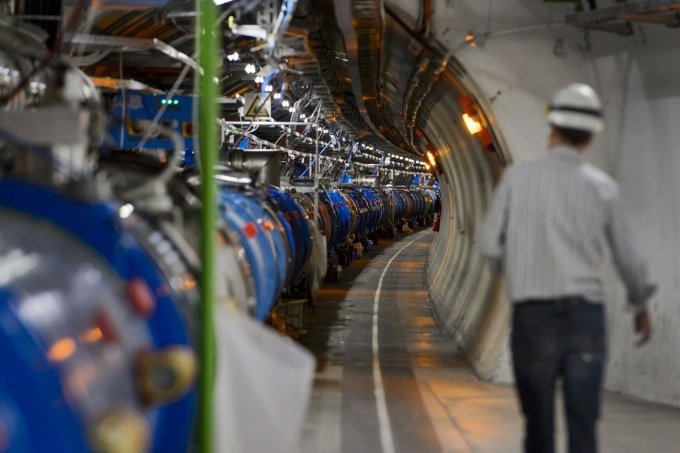The Large Hadron Collider — the particle accelerator used to discover the Higgs boson in 2012 — is being fired back up after a two-year break.
The gigantic collider (which includes a 17-mile-long underground tunnel that runs between France and Switzerland) was shut down in February 2013 so engineers could make upgrades. Now, physicists are starting it back up for a new series of experiments intended to push the laws of physics to their limits…
In essence, these experiment involve shooting beams of particles around the ring, using enormous magnets to speed them up to 99.9999 percent of the speed of light (causing them to whip around the ring about 11,000 times per second), then crashing them together. Sophisticated sensors capture all sorts of data on the particles that result from these collisions.
The huge amount of energy present in these collisions leads the particles to break apart and recombine in some pretty exotic ways. And these conditions can reveal flaws in the standard model of physics — currently our best formula for predicting the behavior of all matter.
Physicists want to do this because, as accurate as the standard model seems to be, it’s still incomplete…
The LHC’s biggest finding so far was the July 2012 discovery of an elementary particle called the Higgs boson.
Since the 1960s, the Higgs boson was thought to exist as a part of the Higgs field: an invisible field that permeates all space and exerts a drag on every particle. This field, physicists theorized, is why we perceive particles to have mass…
On paper, the Higgs field and boson both made a lot of sense — all the equations of the standard model pointed toward their existence. But we had no direct physical evidence of them…
After several years of upgrading the LHC’s magnets (which speed up and control the flow of particles) and data sensors, it’ll begin…a new series of experiments that will involve crashing particles together with nearly twice as much energy as before.
These more powerful collisions will allow scientists to keep discovering new (and perhaps larger) particles, and also look more closely at the Higgs boson and observe how it behaves under different conditions…
Once upon a time, it looked like a truly gigantic accelerator would actually be built in the US. In 1989, Congress agreed to spend $6 billion to build the Superconducting Super Collider: a 54-mile-long underground ring in Waxahachie, Texas, that would have produced collisions with five times as much energy as the LHC’s. But in 1993, with the costs rising to a projected $11 billion, Congress killed the project — after $2 billion had already been spent on drilling nearly 15 miles of tunnel.
Just in case you thought stupid was a new definition of Congressional priorities.
Invading other countries because liars in the White House say we must; building new fleets of fighter jets and ships to protect landing craft for future invasions because liars in the military-industrial complex say we must; building bridges to nowhere instead of repairing and improving our nation’s infrastructure because powerful members of Congress say we must – are the kinds of commitments to increasing the national debt that our politIcians adore, the average American loves. The size of the “Boom” is sufficiently impressive to draw everyone’s attention away from the results of science and studies headquartered outside our borders.
And TV news-as-entertainment gets to fill the space where conversation used to get in the way with beaucoup footage of all the people around the world who love Americans more than ever.
Who needs science, anyway?
Addendum: Ursarodinia sent me this link this morning – before the LHC post; but, I didn’t get round to checking my email until late this afternoon.
